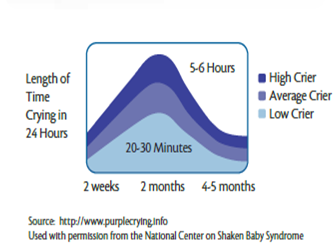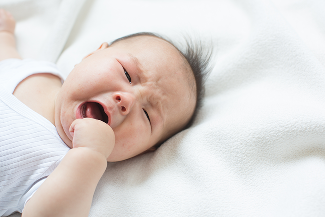All babies cry. Crying is how babies tell you that they need something. Some babies cry more than others. Understanding why your baby might be crying can help you soothe your baby.
Sometimes a baby cannot be comforted, no matter how hard you try. You may feel overwhelmed; many parents have these feelings. If you soothe your baby throughout the day (not just when baby cries), it may help reduce how much and how hard your baby cries.
A crying baby…
- is not being bad
- is not angry with you
- does not mean that you are a bad parent
Most babies

- start crying at birth
- cry the most at about two months
- start crying less at three to five months
Why might my baby be crying?

If your baby is crying and is opening their mouth, they may be hungry. You can try feeding them.

If your baby is making facial grimaces or is straining, they may have gas pain. You can try burping your baby or rubbing and gently patting their back or stomach.

If your baby is crying and is reaching out to you, they may need to be held or touched. You can try holding baby to your chest, carrying them in a carrier or sling or gently rubbing their tummy or back.

If your baby is crying and their…
- ears or calves are very cold
- skin looks marbled
- nails or lips are blue
…your baby might be too cold. You can try holding them close to you and adding a layer of clothing.

If your baby is crying and is rubbing their eyes or has droopy eyelids, they may be tired. Try putting baby down for a nap.

If your baby is crying and keeps looking away, they may be overstimulated. You can try:
- reducing noise, light and movement
- taking baby to a quiet room
- singing or “shushing” gently

If your baby is crying and has a wet or soiled diaper, they may be uncomfortable or their skin is being irritated. You can try changing baby’s diaper, using a cream if they have a rash or giving some time without a diaper on.

If your baby is crying and is sweating on the back of the neck or has warm ears and calves, they may be too hot. You can try removing some clothing or taking baby to a cooler location.

If your baby is crying and wants your attention, they may be bored. You can try talking, singing and playing with baby or changing their position.

If your baby is crying and wants to relax or be soothed, they may want to breastfeed/chestfeed or may need to suck. You can try:
- breastfeeding/chestfeeding
- letting your baby suck on their hand
- holding your baby skin to skin
- singing to your baby
- rocking your baby gently

If your baby is crying and just keeps crying, they may just need to cry. You can put on some white noise, like a vacuum cleaner, or try any of the tips above.
You know your baby best.
If you think they might be sick, contact your doctor, public health nurse, or call Health Links – Info Santé anytime at (204) 788-8200 or toll-free 1-888-315-9257.
Staying calm when your baby cries
Sometimes a baby will continue to cry even though they are not sick, hungry or needing a diaper change. This can feel overwhelming. Staying calm is the best way to soothe your baby. When you are calm, it is easier to listen and discover what your baby needs. Remember, you’re not alone. All babies go through a crying phase. It won’t last forever.
These tips can help you relax, stay calm and cope while your baby is crying.
Take a break – Gently place your baby on their back in the crib and leave the room. Check on your baby every five to 10 minutes. Your baby will be safe, and you can use the time to calm down.
Breathe slowly – Take three to 10 long, slow breaths through your nose to feel calmer.
Call a friend or family member – Ask them to come over or talk on the phone. Share your feelings with them.
Ask for help – If you need a break, let your partner, neighbour or family member care for your baby.
The Period of PURPLE Crying website has lots of good information on causes of crying and how to soothe your baby.


